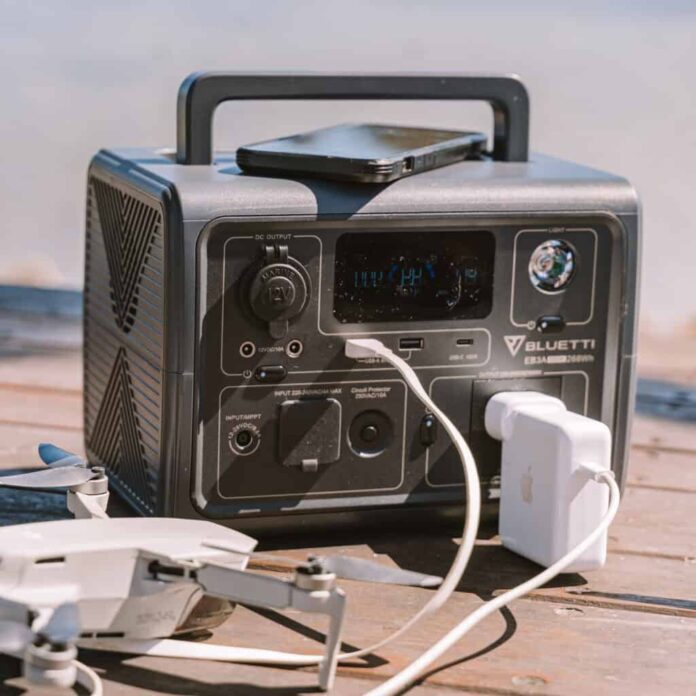Many years ago at the dawn of the personal computer age, I had a CP/M-based microcomputer in my basement. It ran with 2, 8-inch floppy disk drives, a DEC display and keyboard, and a CPU that required me to flip 8 DIP switches to get a prompt to appear on the screen. I also had a dot matrix printer. All of these were plugged into an uninterruptible power supply (UPS) that featured a lead-acid car battery housed in an enclosure with several plug outlets. In the event of a power failure, the battery would give me five minutes of power to finish my work and shut everything down.
That was a long time ago. My setup today includes a lot more. Our home is populated with two smartphones, a tablet, an eReader, a Chromebook laptop, an Acer Nitro PC Tower, and an HP all-in-one inkjet printer. I haven’t included the two flat-screen televisions, two DVD players, and the wireless modem/router that connects everything. It is a lot of power-hungry devices.
In our apartment, we can plug all of these devices into power bars and wall outlets. A UPS is not usually top of mind in this type of setting. But portable power generation has its place and can be handy when there is no power source or the electricity fails.
That’s where Bluetti has focused its business and the EB3A is its compact UPS with many terrific features. When it showed up at my door in August of last year I wondered where it would be of service for us. Most of the applications I thought about weren’t necessarily a fit for my current mid-70-year-old lifestyle. A UPS would be handy for:
- providing electricity for camping and other outdoor activities.
- power for remote location work when electricity is unavailable.
- a mobile power source for an automobile, truck, camper, or boat to be used to charge electronic refrigerators, and cooktops, and to be used to recharge smartphones, tablets and laptops.
- a portable power source that can recharge a car battery and even an electric vehicle.
- Combined with a solar panel it could provide power to run appliances in an off-the-grid home or in an on-the-grid one when the power fails.
For our apartment, the immediate use would be as:
- an emergency UPS in the face of a power blackout.
- a power source should a natural disaster occur.
- a power source for life-sustaining medical equipment in the home.
My first attempts to use the EB3A right out of the box met with disappointment. We live in a fully equipped, brand-new two-bedroom apartment with all the latest appliances and built-ins. So I thought I would charge the EB3A and then plug in our brand-new electric kettle to make tea. I didn’t realize that the kettle had a 1,000-watt requirement but the EB3A was restricted in its ECO power mode to 600 watts. I learned my lesson and read the manual with greater attention to the details.
So since that first failure to launch, I have explored how to make the UPS work for us. We don’t go camping. We don’t take long road trips anymore. There is no place in the apartment devoid of power. Even the balcony has a power outlet.
My primary use for the EB3A right now is to use it as a UPS battery backup for my new Acer Nitro Tower PC with its LG 35” display. As a UPS it is doing the job when I have deliberately pulled the plug. The lithium iron phosphate (LiFePO4) battery is working as advertised and can keep my PC powered, so far, for at least 30 minutes which has been the limit of my testing to date.
LiFePO4 batteries are much safer than Lithium-ion (Li-ion) which can be found in smartphones, laptops, tablets and Tesla EVs. LiFePO4 batteries are less prone to overheating and tolerate higher numbers of charge-discharge cycles than Li-ion before load capacity starts to drop.
As for what is onboard the EB3A: it has two standard AC plugs, two USB-A compatible ports, a USB-C port, a very bright LED light that offers three settings, the last a flashing emergency light signal, a DC 5521 port to power laptops, external hard drives and audio equipment, a cigarette lighter DC port like the ones used in automobiles and a large LCD information display that tracks power input and output and tells you if UPS, AC, or DC are on. A battery indicator tracks how many hours remain when using it as a UPS.
There are three power settings: the one I mentioned earlier called ECO, then Standard and finally Power Lifting Mode.
In ECO, power to both the AC and DC output automatically shuts down after 4 hours to save the battery.
In Power Lifting Mode, the voltage can be adjusted to run higher power-demand devices up to 1,200 Watts (it would have worked with my kettle).
The EB3A came with a solar charging cable for connecting a 200-watt photovoltaic panel and a USB-C cable. The UPS when plugged into the AC port of a portable generator can provide power to the two AC plug outlets.
A car charging cable is an optional accessory which can be plugged into the DC5521 port. It can provide slow charging for a Tesla EV. No other EV manufacturer is mentioned in the technical literature.
I downloaded the EB3A smartphone app from the Google Play Store which makes it possible for me to access the UPS dashboard on my phone. The app includes helpful video tutorials and guidelines as well.
Although my Google Pixel 7a phone can be used with a wireless charger, I still haven’t been able to get the EB3A’s wireless charging feature to work. I’ll do a little more digging and still have much to learn about this small, yet powerful UPS.
















